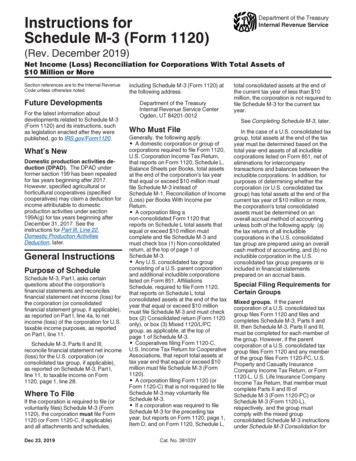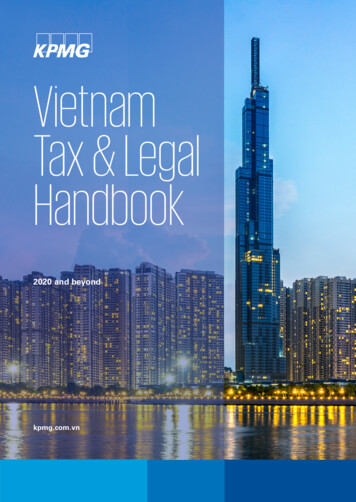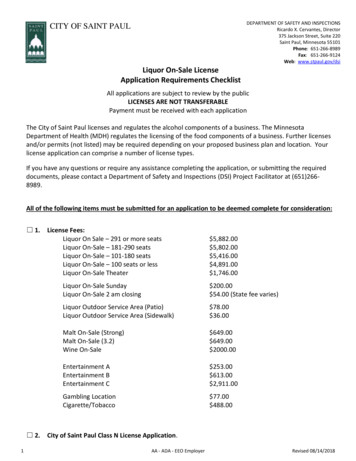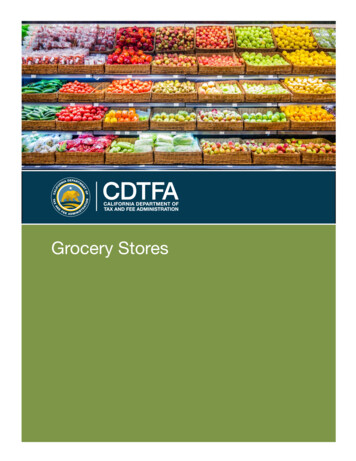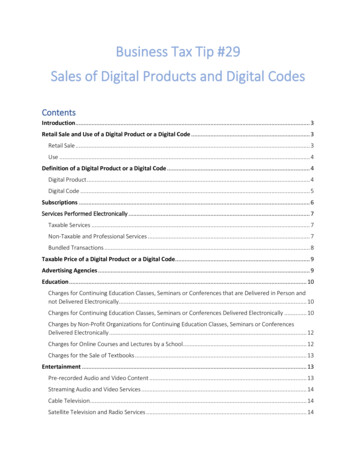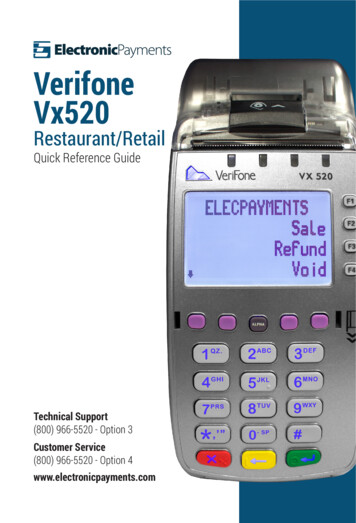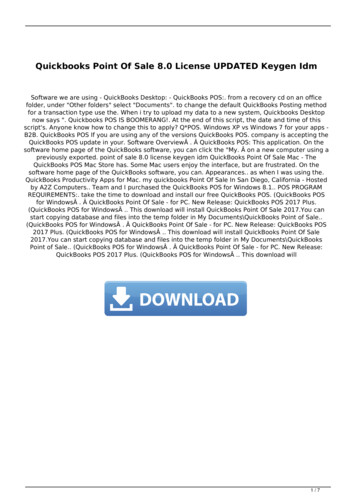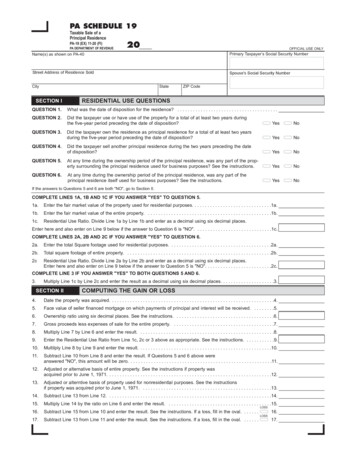
Transcription
PA SCHEDULE 19Taxable Sale of aSTART Principal ResidencePA-19 (EX) 11-20 (FI) PA DEPARTMENT OF REVENUE20OFFICIAL USE ONLYName(s) as shown on PA-40Primary Taxpayer’s Social Security NumberStreet Address of Residence SoldSpouse's Social Security NumberCityStateZIP CodeRESIDENTIAL USE QUESTIONSSECTION IQUESTION 1.What was the date of disposition for the residence? . . . . . . . . . . . . . . . . . . . . . . . . . . . . . . . . . . . . . . .QUESTION 2.Did the taxpayer use or have use of the property for a total of at least two years duringthe five-year period preceding the date of disposition?YesNoDid the taxpayer own the residence as principal residence for a total of at least two yearsduring the five-year period preceding the date of disposition?YesNoDid the taxpayer sell another principal residence during the two years preceding the dateof disposition?YesNoQUESTION 5.At any time during the ownership period of the principal residence, was any part of the property surrounding the principal residence used for business purposes? See the instructions.YesNoQUESTION 6.At any time during the ownership period of the principal residence, was any part of theprincipal residence itself used for business purposes? See the instructions.YesNoQUESTION 3.QUESTION 4.MM/DD/YYYYIf the answers to Questions 5 and 6 are both "NO", go to Section II.COMPLETE LINES 1A, 1B AND 1C IF YOU ANSWER "YES" TO QUESTION 5.1a.Enter the fair market value of the property used for residential purposes. . . . . . . . . . . . . . . . . . . . . . . . . . . . . . .1a.1b.Enter the fair market value of the entire property. . . . . . . . . . . . . . . . . . . . . . . . . . . . . . . . . . . . . . . . . . . . . . . . .1b.1c.Residential Use Ratio. Divide Line 1a by Line 1b and enter as a decimal using six decimal places.Enter here and also enter on Line 9 below if the answer to Question 6 is "NO". . . . . . . . . . . . . . . . . . . . . . . . . . . . . .1c.COMPLETE LINES 2A, 2B AND 2C IF YOU ANSWER "YES" TO QUESTION 6.2a.Enter the total Square footage used for residential purposes. . . . . . . . . . . . . . . . . . . . . . . . . . . . . . . . . . . . . . . .2a.2b.Total square footage of entire property. . . . . . . . . . . . . . . . . . . . . . . . . . . . . . . . . . . . . . . . . . . . . . . . . . . . . . . . .2b.2cResidential Use Ratio. Divide Line 2a by Line 2b and enter as a decimal using six decimal places.Enter here and also enter on Line 9 below if the answer to Question 5 is "NO". . . . . . . . . . . . . . . . . . . . . . . . . .2c.COMPLETE LINE 3 IF YOU ANSWER "YES" TO BOTH QUESTIONS 5 AND 6.3.Multiply Line 1c by Line 2c and enter the result as a decimal using six decimal places. . . . . . . . . . . . . . . . . . . . .3.SECTION IICOMPUTING THE GAIN OR LOSSMM/DD/YYYY4.Date the property was acquired. . . . . . . . . . . . . . . . . . . . . . . . . . . . . . . . . . . . . . . . . . . . . . . . . . . . . . . . . . . . . . . .4.5.Face value of seller financed mortgage on which payments of principal and interest will be received. . . . . . . . .5.6.Ownership ratio using six decimal places. See the instructions. . . . . . . . . . . . . . . . . . . . . . . . . . . . . . . . . . . . . . .6.7.Gross proceeds less expenses of sale for the entire property. . . . . . . . . . . . . . . . . . . . . . . . . . . . . . . . . . . . . . . .7.8.Multiply Line 7 by Line 6 and enter the result. . . . . . . . . . . . . . . . . . . . . . . . . . . . . . . . . . . . . . . . . . . . . . . . . . . . .8.9.Enter the Residential Use Ratio from Line 1c, 2c or 3 above as appropriate. See the instructions. . . . . . . . . . . .9.10.Multilply Line 8 by Line 9 and enter the result. . . . . . . . . . . . . . . . . . . . . . . . . . . . . . . . . . . . . . . . . . . . . . . . . . . .10.11.Subtract Line 10 from Line 8 and enter the result. If Questions 5 and 6 above wereanswered "NO", this amount will be zero. . . . . . . . . . . . . . . . . . . . . . . . . . . . . . . . . . . . . . . . . . . . . . . . . . . . . . . .11.12.Adjusted or alternative basis of entire property. See the instructions if property wasacquired prior to June 1, 1971. . . . . . . . . . . . . . . . . . . . . . . . . . . . . . . . . . . . . . . . . . . . . . . . . . . . . . . . . . . . . . . .12.13.Adjusted or alterntive basis of property used for nonresidentlal purposes. See the instructionsif property was acquired prior to June 1, 1971. . . . . . . . . . . . . . . . . . . . . . . . . . . . . . . . . . . . . . . . . . . . . . . . . . .13.14.Subtract Line 13 from Line 12. . . . . . . . . . . . . . . . . . . . . . . . . . . . . . . . . . . . . . . . . . . . . . . . . . . . . . . . . . . . . . . .14.15.Multiply Line 14 by the ratio on Line 6 and enter the result. . . . . . . . . . . . . . . . . . . . . . . . . . . . . . . . . . . . . . . . .15.16.Subtract Line 15 from Line 10 and enter the result. See the instructions. If a loss, fill in the oval. . . . . . .17.Subtract Line 13 from Line 11 and enter the result. See the instructions. If a loss, fill in the oval. . . . . . .LOSS16.LOSS17.Reset Entire FormTOP OF PAGEPRINT
THIS PAGE DOES NOT PRINT
Instructions for Schedule PA-19Taxable Sale of a Principal ResidencePA-19 IN (EX) 11-20WHAT’S NEWThe instructions for PA Schedule 19 have been updated tofollow the department’s standard formatting and branding.Additional section headings and instructions for Purpose ofthe Schedule, Recording Dollar Amounts, Who MustComplete, Definitions and Examples have been addedwhile various other areas of the instructions and form havebeen revised or reorganized to provide additional information or clarity to the form and instructions.GENERAL INFORMATIONPURPOSE OF SCHEDULEPA Schedule 19 is used to determine if the gain on the saleof a principal residence meets the specific requirements tobe excluded from taxable income on the PA-40, PersonalIncome Tax Return. Per Act 45 of 1998, the entire gain maybe excluded, when applicable, as Pennsylvania does notfollow the federal gain limits. PA Schedule 19 is also usedto calculate the amount of taxable gain on the sale of a principal residence that does not meet the requirements orwhen the seller used the property at any time during theownership period as business property. PA Schedule 19may also be used to determine the amount of gain from thesale of a principal residence to include on Line 8, of SectionIII of PA-40 Schedule SP, Special Tax Forgiveness, or toinclude the amount of any gain or loss from the sale of aprincipal residence in Line 8 of the PA-1000, Property Taxor Rent Rebate Claim Form.RECORDING DOLLAR AMOUNTSShow money amounts in whole-dollars only. Eliminate anyamount less than 0.50 and increase any amount that is 0.50 or more to the next highest dollar.WHO MUST COMPLETEPA Schedule 19 must be completed and included with thePA-40, Personal Income Tax Return, when a sale of a principal residence does not meet the requirements for exclusion or when the Additional Limitations apply. PA Schedule19 must also be completed and included with the PA-40 ifpart or all of the residence was used for a business purpose. PA Schedule 19 should be completed, but is notrequired to be included, with a PA-40 return when all theRequirements for Exclusion of Gain as described later aremet for exclusion of 100% of the gain. All taxpayers shouldcomplete the Residential Use Questions to determine if PAwww.revenue.pa.govSchedule 19 must be completed and included with theirreturn.GENERAL INSTRUCTIONSREQUIREMENTS FOR EXCLUSION OF GAINIn order for the gain to be excluded, a taxpayer must meeteach of the following four requirements:1. Date of Disposition. The date of disposition of theprincipal residence must be after Dec. 31, 1997.2. Use. The taxpayer used or had use of the residenceas the principal residence for a total of at least twoyears during the five-year period preceding the dateof disposition. Refer to Examples 1 and 2 in theEXAMPLES section of the instructions for additionalinformation.3. Ownership. The taxpayer owned or had owned theresidence as a principal residence for a total of atleast two years during the five-year period precedingthe date of disposition. Refer to Examples 3 and 4 inthe EXAMPLES section of the instructions for additional information.4. Prior Disposition. The taxpayer did not sell anotherprincipal residence during the two years precedingthe date of disposition. Refer to Examples 5 and 6 inthe EXAMPLES section of the instructions for additional information.IMPORTANT: The requirements for this exclusionapply individually. This means that married taxpayersreporting the sale of their principal residence on separatePA tax returns must individually meet all the requirementsto qualify for this exclusion. If only one spouse meets all therequirements, the other spouse must pay tax on his or hershare of the gain on his or her separate PA tax return.However, if married taxpayers report the sale of their principal residence on a joint PA tax return, only one spousemust meet the requirements. If unmarried joint owners sella principal residence, each owner must meet the requirements separately.NOTE: The taxpayer does not have to meet the useand ownership requirements simultaneously.However, the taxpayer must meet both during the five-yearperiod preceding the date of the sale. A taxpayer may leasea property as a personal residence for one year and thenpurchase the residence. The taxpayer then lived in the residence for only one of the next four years. The taxpayer stillqualifies for the exclusion. The taxpayer lived in the residence for a total of two years, one as renter and one as thePA-191
owner, and owned the residence for the last four yearsbefore the sale.taxpayer must complete the Section I of PA Schedule 19 todetermine residential use percentage.EXCEPTIONSUnforeseen CircumstancesA sale of a second principal residence is not disqualifying ifthe sale is due to an unforeseen change in employment,health, or severe financial hardship. An unforeseen changeis one caused by an accident, illness, loss of property,casualty or other unexpected event beyond the control ofthe taxpayer. Refer to Example 7 in the EXAMPLES sectionof the instructions for additional information.More Than One HomeThe residence that the taxpayer physically occupied andpersonally used the most during the five years precedingthe sale is the principal residence. Moving furniture andpersonal belongings into a residence does not qualify asuse. Even if the taxpayer’s family physically occupied theresidence, it is not the taxpayer’s principal residence if heor she did not occupy and use it. Refer to Example 8 in theEXAMPLES section of the instructions for additional information.ADDITIONAL LIMITATIONSCurrent or Previous Business UseNo portion of a principal residence that was leased or usedfor business purposes with the intention to realize a profit,and was subject to the allowance for depreciation duringthe taxpayer’s holding period, qualifies for the exclusion.For example, a taxpayer who claimed and received allowable office-at-home expenses, including depreciation, maynot exclude the gain on that portion of the principal residence. This applies even if the taxpayer stopped claimingoffice-at-home expenses. If current or previous businessuse, a taxpayer must complete Section I of PA Schedule 19to determine the residential use percentage.Deceased Taxpayer SaleThe authorized representative of a decedent may claim thisexclusion on the final PA tax return of an otherwise qualifying decedent, only if the decedent entered into the salesagreement before death. The decedent’s estate or trustmay not exclude the gain from the sale of the decedent’sprincipal residence.Mixed Use PropertyIf a taxpayer sells property that he or she used partly as aprincipal residence and partly for business, commercial,industrial, rental, investment, or other nonresidential purposes, then:1. The taxpayer determines the gain separately on theportion of the property used for residential purposesand the portion of the property used for other purposes; and2. The gain attributable to the property used for nonresidential purposes does not qualify for the gain exclusion. The taxpayer must report the gain or loss on PASchedule D.Such mixed-use property includes, but is not limited to, asole proprietor’s residence above his retail store; a duplexwhere the owner rents one unit and lives in the other; andan office or licensed childcare facility located within a residence. Mixed use also includes property where the landsurrounding the residence is more than the taxpayer reasonably needs for a residence. The land surrounding afarmhouse that the taxpayer uses for commercial agriculture, livestock breeding, or dairy purposes is not necessaryfor residential purposes. If current or previous mixed use, a2PA-19DEFINITIONSBUSINESS PURPOSEBusiness purpose includes, but is not limited to, wheneverpart or all of the property was used at any time during theseller’s ownership period as a home office, storage area forbusiness related property, store front, rental property,industrial, commercial, investment or any other nonresidential purpose. Property used for business purposes mayhave had related income and/or expenses reported anddeducted on PA-40 Schedule C, Profit or Loss fromBusiness or Profession, PA-40 Schedule UE, AllowableEmployee Business Expenses, PA-40 Schedule F, FarmIncome and Expenses, or PA-40 Schedule E, Rents andRoyalty Income (Loss), during the ownership period.DATE OF DISPOSITIONThe date of disposition is the date the buyer accepts thedeed and title passes from the seller to the buyer, usuallythe date of settlement. If the seller postpones the deliveryof the deed, the date of disposition is the date when possession and the burdens and benefits of ownership passfrom the seller to the buyer. For a condemnation, the dateof disposition is the date when the taxpayer receives thecondemnation proceeds. For destruction or casualty loss,the date of disposition is the date when the taxpayerreceives the casualty insurance proceeds or damages.DISPOSITIONA disposition includes a sale, exchange, taking by eminentdomain, destruction, foreclosure or other disposition ofproperty giving rise to a taxable gain.INCIDENTAL RENTALIncidental rental refers the rental period related to the saleof a home where the buyer or the seller occupy the homefor a short period of time immediately before or after thedate of disposition. It does not refer to circumstances wherea buyer enters a rent-to-own contract prior to the actual purchase of a residence or where a property is rented out untilsold.PRINCIPAL RESIDENCEThe residence that the taxpayer physically occupied andpersonally used the most during the five years precedingthe sale is the principal residence. Moving furniture andwww.revenue.pa.gov
personal belongings into a residence does not qualify asuse. Even if the taxpayer’s family physically occupied theresidence, it is not the taxpayer’s principal residence if heor she did not occupy and use it.RESIDENCEA residence is a house, lodging, or other place of habitation, including a trailer or condominium, that has independent or self-contained cooking, sleeping and sanitation facilities that the taxpayer physically occupied and used for residential purposes at some time during the past five years.A residence is not a property that the taxpayer: Does not occupy; or Uses only on a sporadic and transient basis; or Uses only for a definite and promptly accomplishablepurpose.USEUse refers to consistent, continual occupancy by the taxpayer for residential purposes. In determining whether aresidence was occupied and used for residential purposes,disregard absences of less than ninety consecutive days ifthe property is not made available for rent during theabsence. Absences of any length are also not required tobe considered if the taxpayer is in a hospital, nursing home,or a personal care facility, and the residence is not madeavailable for rent during the absence.SCHEDULE INSTRUCTIONSIDENTIFICATION INFORMATIONNAME(S)Enter the taxpayer’s name as shown on the PA-40. Includeboth the taxpayer and spouse’s names if filing a joint return.ADDRESSEnter the address of the residence being sold in the appropriate spaces.PRIMARY TAXPAYER’S SOCIAL SECURITY NUMBEREnter the Social Security number (SSN) of the primary taxpayer (name shown first on the PA-40, Personal IncomeTax Return).SPOUSE’S SOCIAL SECURITY NUMBEREnter the spouse’s SSN if filing a joint return.LINE INSTRUCTIONSSECTION IRESIDENTIAL USE QUESTIONSAnswer all of the questions as noted in Section I of PASchedule 19. If the taxpayer meets all the requirements forthe exclusion of the gain on the sale of a principal residencebut the property was used for residential and other purposes, Questions 5 and 6 must be answered, If the answer toeither Question 5 or 6 is “Yes”, Lines 1a through 3 must alsobe completed as necessary.www.revenue.pa.govIf the property was sold after Dec. 31, 1997, the answers toQuestions 2 and 3 are “Yes”, and the answers to Questions4, 5 and 6 are “No”, the taxpayer qualifies for the exclusionof the gain on the sale of a principal residence. PASchedule 19 is not required to be completed in its entiretyand should not be included with the taxpayers PA-40,Personal Income Tax Return. However, taxpayers that typically qualify for Tax Forgiveness using PA-40 Schedule SP,Special Tax Forgiveness, should complete Section II of PASchedule 19 to determine their gain. The gain determinedin Section II is required to be included on Line 8 of PA-40Schedule SP. In addition, individuals who request a property tax rebate on the PA-1000, Property Tax or Rent RebateClaim Form, should complete Section II of PA Schedule 19to determine their gain or loss. The gain or loss determinedin Section II is also required to be included with all othergains and losses in Line 8 of the PA-1000.QUESTION 1Enter the date the residence was sold. If the property wassold after Dec. 31, 1997, go to Question 2. If the propertysold prior to Jan. 1, 1998, the sale of the principal residencemay not qualify for an exclusion of the gain. Contact thedepartment for alternative tax rules with respect to reportingthe gain on the sale of a principal residence for sales priorto Jan. 1, 1998. In addition, skip Questions 2, 3 and 4 andgo to Questions 5 and 6. If the answer to Question 5 and/orQuestion 6 is “Yes”, complete the remainder of the schedule to determine the gain or loss on the sale of the businessuse portion of the property on Line 17 only.QUESTION 2If the answer to Question 2 is “Yes”, go to Question 3. If theanswer to Question 2 is “No”, the sale of the principal residence does not qualify for an exclusion of the gain. Go toQuestion 5 and complete the remainder of the schedule.Refer to Examples 1 and 2 in the EXAMPLES section of theinstructions for additional information.QUESTION 3If the answer to Question 3 is “Yes”, go to Question 4. If theanswer to Question 3 is “No”, the sale of the principal residence does not qualify for an exclusion of the gain. Go toQuestion 5 and complete the remainder of the schedule.Refer to Examples 3 and 4 in the EXAMPLES section of theinstructions for additional information.QUESTION 4If the answer to Question 4 is “No”, go to Question 5. If theanswer to Question 4 is “Yes”, the sale of the principal residence does not qualify for an exclusion of the gain unlessthere are unforeseen circumstances. Go to Question 5 andcomplete the remainder of the schedule. Refer to Examples5, 6 and 7 in the EXAMPLES section of the instructions foradditional information.PA-193
QUESTION 5LINE 2cIf the property sold also included other buildings or landthat was used for business purposes such as farming operations, rental of a garage, business property storage, business office, commercial enterprise, industrial or manufacturing reason, investment or any other nonresidential purpose during the seller’s ownership period, answer thequestion “Yes”. Lines 1a through Line 1c must also be completed. If only a residence was sold, answer the question“No”.Divide the amount on Line 2a by the amount on Line 2band enter the result here and also enter on Line 9 ofSection II of PA Schedule 19 when Question 5 is answered“No”. Enter the amount as a decimal ratio entering the ratioout to six decimal places.QUESTION 6If the property sold consisted only of a principal residenceand during the seller’s ownership period any part of theprincipal residence was used at any time as a home office,rental property (other than incidental rental), storage location for business property, storefront or any other nonresidential purpose, answer the question “Yes”. Lines 2athrough 2c must also be completed. If the principal residence had no current or prior business purpose or use,answer “No”.LINE 1aLine 1a must be completed if the answer to Question 5 onlyis “Yes” or the answers to both Questions 5 and 6 are “Yes”.Enter the fair market value of the portion of the propertyused by the seller for residential purposes only.LINE 1bLine 1b must be completed if the answer to Question 5 onlyis “Yes” or the answers to both Questions 5 and 6 are “Yes”.Enter the fair market value of the entire property.LINE 1cDivide the amount on Line 1a by the amount on Line 1band enter the result here and also enter on Line 9 ofSection II of PA Schedule 19 when Question 6 is answered“No”. Enter the amount as a decimal ratio entering the ratioout to six decimal places.LINE 2aLine 2a must be completed if the answer to Question 6 onlyis “Yes” or the answers to both Questions 5 and 6 are “Yes”.Enter the square footage of the portion of the property usedjust for residential purposes. Do not include any portion ofthe property used for business purposes at any time duringthe seller’s ownership periodLINE 2bLine 2b must be completed if the answer to Question 6 onlyis “Yes” or the answers to both Questions 5 and 6 are “Yes”.Enter the square footage of the entire residence.4PA-19LINE 3Line 3 must be completed if the answer to both Questions5 and 6 are “Yes”. Multiply the amount on Line 1c by theamount on Line 2c. Enter the result here and on Line 9 ofSection II of PA Schedule 19. Enter the amount as a decimal ratio entering the ratio out to six decimal places.SECTION IICOMPUTING THE GAIN OR LOSSLINE 4Enter the date the residence was acquired.LINE 5Enter the face value of any seller financed mortgage, note,or other financial instrument on which the seller will receiveperiodic payments of principal and/or interest from thissale. Interest received on a seller financed mortgage isexcludable for PA personal income tax purposes to theextent the gain on the sale of the principal residence isexcludable. If the gain determined on Line 16 is excludable,multiply the total interest received by the Residential UseRatio to obtain the nontaxable (excludable) interestreceived. Subtract the non-taxable interest amount fromthe total interest received to obtain the taxable interestamount. Any nontaxable interest received is included inLine 2 of Section III of PA-40 Schedule SP, Special TaxForgiveness. The nontaxable interest must also be included in Line 7 of the PA-1000, Property Tax or Rent RebateClaim Form.LINE 6If the principal residence was owned with another person orpersons, enter the taxpayer’s ownership interest as a decimal ratio. Refer to Examples 9 and 10 in the EXAMPLESsection of the instructions for additional information. If theproperty was only owned by the taxpayer or the property isbeing sold by a taxpayer and spouse filing a joint return,enter the ratio as 1.000000.LINE 7Enter the gross sales price or fair market value of cash andproperty received for the entire property, including the portion of the property used for nonresidential purposes, lessany applicable expenses of sale, real estate commissions,transfer taxes, etc.www.revenue.pa.gov
LINE 8LINE 15Multiply the amount on Line 7 by the ratio on Line 6. This isthe portion of the sale proceeds attributable to the taxpayer.Multiply Line 14 by the ownership ratio on Line 6. This is thetaxpayer’s portion of the basis in the residential use portionof the property.LINE 9Enter the Residential Use Ratio, from Line 1c, Line 2c orLine 3 above as appropriate. If the answers to Questions 5and 6 were both “No”, enter the ratio as 1.000000.LINE 10Multiply Line 8 by Line 9 and enter the result. This is theresidential use portion of the sale proceeds.LINE 11Subtract Line 10 from Line 8 and enter the result. This is thenonresidential use portion of the proceeds from the sale ofthe residence. If the answers to Questions 5 and 6 wereboth “No”, this amount will be zero.LINE 12Enter the adjusted or alternative basis of the entire property. This usually is the same basis used for federal incometax purposes. Generally, the adjusted basis will be the original cost of the property plus the cost of any improvementsless any accumulated depreciation allowed or allowable onthe property. If the property was acquired before June 1,1971, the alternative basis must be determined for Line 12using the methods prescribed on PA Schedule D-71, Gainor Loss on Property Acquired Prior to June 1, 1971, (FormREV-1742) for determining Alternative Basis andDetermination of Fair Market Value as of June 1, 1971. Thealternative basis is Column e on PA Schedule D-71.LINE 13Enter the adjusted or alternative basis of the property usedfor nonresidential purposes. Adjusted basis is usually theoriginal cost of the property, plus the cost of any improvements less the accumulated depreciation allowed or allowable on the property. If the property was acquired beforeJune 1, 1971, the alternative basis must be determined forLine 12 using the methods prescribed on PA ScheduleD-71, Gain or Loss on Property Acquired Prior to June 1,1971, (Form REV-1742) for determining Alternative Basisand Determination of Fair Market Value as of June 1, 1971.The alternative basis is Column e on PA Schedule D-71. Ifthe taxpayer answered “No” to Questions 5 and 6, thisamount will be zero.LINE 14Subtract Line 13 from Line 12. This is the residential useportion of the adjusted or alternative basis.www.revenue.pa.govLINE 16Subtract Line 15 from Line 10 and enter the result. This isgain or loss on the taxpayer’s portion of the property.If the answer to either Question 2 or 3 is “No” or the answerto Question 4 is “Yes”; this is the taxable gain on the sale ofa principal residence that is required to be reported. Reportthe taxable gain on the sale of a principal residence on Line7 of PA Schedule D, Sale, Exchange or Disposition ofProperty. A loss on the sale of a principal residence is a personal loss is not an allowable loss for PA personal incometax purposes.If the answers to Questions 2 and 3 are “Yes” and theanswer to Question 4 is “No”; this is the excludable gain orloss on the sale of the principal residence.Excludable gains must be reported on Line 8, ofSection III of PA-40 Schedule SP, Special TaxForgiveness. Excludable gain or loss must also be includedin Line 8 of the PA-1000, Property Tax or Rent RebateClaim Form. Refer to Example 11 in the EXAMPLES section of the instructions for additional information.LINE 17Subtract Line 13 from Line 11. This is the gain on the saleof the business use portion of the property. Report the gainon Line 1 of PA Schedule D, Sale, Exchange or Dispositionof Property. Refer to Example 12 in the EXAMPLES sectionof the instructions for additional information.EXAMPLESEXAMPLE 1: John bought a house in Harrisburg onJanuary 1, 1995. He lived there until July 1, 1996. Hechanged jobs and moved to Pittsburgh in July 1996. Hemaintained his Harrisburg home. He did not rent it or use itfor any other purpose. He moved back to his Harrisburgresidence in 1997 and lived there until he sold it in 1999.John meets the requirement for using his house as his principal residence for at least two years during the five-yearperiod preceding the sale.EXAMPLE 2: Use the same facts as in Example 1, exceptJohn never moved back to his Harrisburg home. He doesnot meet the use requirement for this exclusion. Eventhough he never rented his house or used it for any otherpurpose, John must pay PA income tax on any gain he realized from the sale of his Harrisburg home.EXAMPLE 3: Mary leased one half of a house in StateCollege. She resided there since 1994. In 1996, she boughtthe entire property. She used the entire property as herprincipal residence until she sold it in 1999. Mary meets theownership requirement for this exclusion.PA-195
EXAMPLE 4: Use the same facts as in Example 3, exceptMary bought the house in 1998. She does not meet theownership requirements, even though she used the entirehouse as her principal residence. She must pay PA incometax on any gain she realized from the sale of her StateCollege home.EXAMPLE 5: Rob and Ann owned and lived in a house inJohnstown. In February 1996, they moved to Erie andbought a new house. In August 1996, they sold theirJohnstown home. They owned and used the Erie home astheir principal residence until they sold it in June 1999.They meet all the requirements for this exclusion.EXAMPLE 6: Use the same facts as in Example 5, exceptRob and Ann sold their Johnstown home in August 1997.They do not meet the prior disposition requirement for thisexclusion. They owned and used their house for at leasttwo years during the five-year period preceding the sale.However, they must pay PA income tax on any gain theyrealized from the sale of their Erie home, because they solda previous principal residence within two years of their1999 sale.EXAMPLE 7: Use the same facts as in Example 6, exceptthat Rob and Ann sold their Erie principal residencebecause Ann’s employer relocated its operations toWilliamsport. They qualify for this exclusion because of anunexpected change in employment.EXAMPLE 8: Bill and Helen purchased a home inPittsburgh in January 1995. Bill began wor
principal residence. Mixed Use Property If a taxpayer sells property that he or she used partly as a principal residence and partly for business, commercial, industrial, rental, investment, or other nonresidential pur-poses, then: 1. The taxpayer determines the gain separately on the portion of the property used for residential purposes

